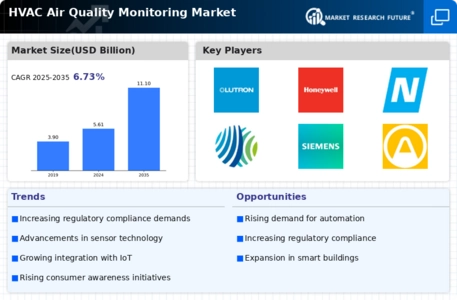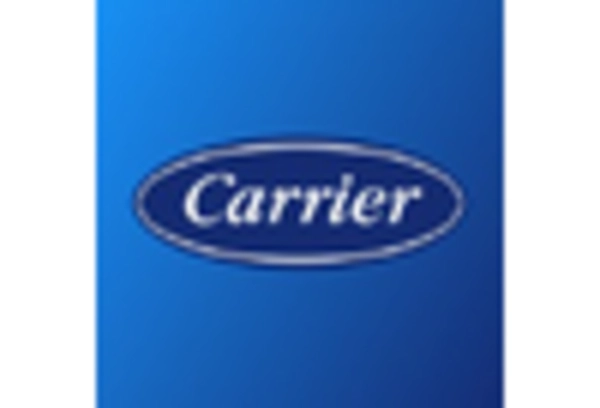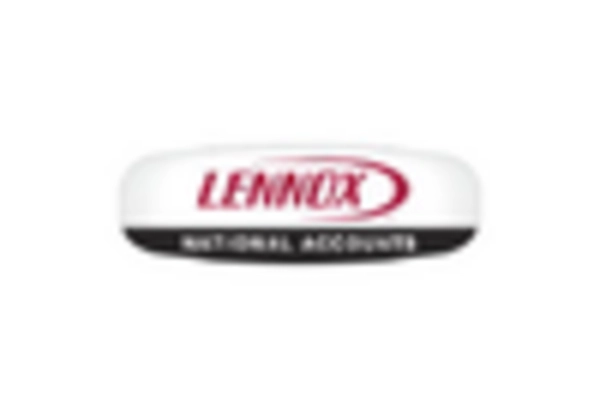Market Growth Projections
The Global HVAC Air Quality Monitoring Market Industry is projected to experience substantial growth over the next decade. With an estimated market value of 5.61 USD Billion in 2024, it is expected to reach 11.1 USD Billion by 2035. This growth reflects a compound annual growth rate (CAGR) of 6.37% from 2025 to 2035. Such projections indicate a robust demand for air quality monitoring solutions, driven by factors such as regulatory compliance, technological advancements, and increasing awareness of indoor air quality.
Regulatory Compliance and Standards
Stringent regulations and standards regarding air quality are shaping the Global HVAC Air Quality Monitoring Market Industry. Governments worldwide are implementing policies to ensure that indoor environments meet specific air quality benchmarks. For example, the Environmental Protection Agency has established guidelines for acceptable levels of indoor pollutants. Compliance with these regulations necessitates the installation of effective monitoring systems within HVAC setups. As a result, the market is poised for growth, with an anticipated CAGR of 6.37% from 2025 to 2035, reflecting the increasing need for compliance-driven solutions.
Increased Focus on Energy Efficiency
The emphasis on energy efficiency in HVAC systems is influencing the Global HVAC Air Quality Monitoring Market Industry. As energy costs rise and environmental concerns grow, there is a push for systems that not only monitor air quality but also optimize energy consumption. Energy-efficient HVAC systems equipped with air quality monitoring capabilities can reduce operational costs while ensuring a healthy indoor environment. This dual focus on efficiency and air quality is likely to attract investments, further propelling market growth. The anticipated CAGR of 6.37% from 2025 to 2035 underscores this trend.
Rising Awareness of Indoor Air Quality
The increasing recognition of the importance of indoor air quality is a primary driver for the Global HVAC Air Quality Monitoring Market Industry. As more individuals become aware of the health implications associated with poor air quality, demand for monitoring solutions is expected to rise. For instance, studies indicate that indoor air can be significantly more polluted than outdoor air, leading to respiratory issues and other health problems. This growing awareness is likely to propel the market, with projections estimating its value at 5.61 USD Billion in 2024. Consequently, stakeholders are investing in advanced HVAC systems that incorporate air quality monitoring features.
Growing Urbanization and Population Density
Rapid urbanization and increasing population density are significant factors driving the Global HVAC Air Quality Monitoring Market Industry. As more people move to urban areas, the demand for effective air quality management in residential and commercial buildings intensifies. Urban environments often experience higher levels of pollution, necessitating robust HVAC systems that can monitor and improve indoor air quality. This trend is expected to contribute to the market's expansion, with a projected value of 5.61 USD Billion in 2024. The need for effective air quality solutions in densely populated areas is likely to remain a priority.
Technological Advancements in Monitoring Solutions
Technological innovations in air quality monitoring devices are driving the Global HVAC Air Quality Monitoring Market Industry. The advent of smart sensors and IoT-enabled devices has enhanced the accuracy and efficiency of air quality assessments. These advancements allow for real-time monitoring and data analytics, enabling users to make informed decisions regarding air quality management. For instance, the integration of machine learning algorithms in HVAC systems can predict air quality fluctuations, optimizing performance. This trend is likely to contribute to the market's growth, with projections indicating a market value of 11.1 USD Billion by 2035.

















Leave a Comment